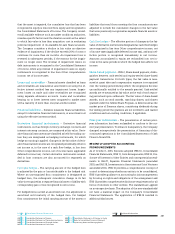Siemens 2014 Annual Report Download - page 256
Download and view the complete annual report
Please find page 256 of the 2014 Siemens annual report below. You can navigate through the pages in the report by either clicking on the pages listed below, or by using the keyword search tool below to find specific information within the annual report.
108 A. To our Shareholders 131 B. Corporate Governance 171 C. Combined Management Report
from these foreign currency revaluations are recognized in net
income. Those foreign currency-denominated transactions
which are classified as non-monetary are remeasured using the
historical spot exchange rate.
Revenue recognition
– Under the condition that persuasive
evidence of an arrangement exists revenue is recognized to the
extent that it is probable that the economic benefits will flow to
the Company and the revenue can be reliably measured, regard-
less of when the payment is being made. In cases where the
inflow of economic benefits is not probable due to customer
related credit risks the revenue recognized is subject to the
amount of payments irrevocably received. Revenue is mea-
sured at the fair value of the consideration received or receiv-
able net of discounts and rebates and excluding taxes or duty.
The Company assesses its revenue arrangements against spe-
cific criteria in order to determine if it is acting as principal or
agent. The following specific recognition criteria must also be
met before revenue is recognized:
Sale of goods: Revenue from the sale of goods is recognized
when the significant risks and rewards of ownership of the
goods have passed to the buyer, usually on delivery of the goods.
Sales from construction contracts: A construction contract is a
contract specifically negotiated for the construction of an asset
or a combination of assets that are closely interrelated or inter-
dependent in terms of their design, technology and function or
their ultimate purpose or use. When the outcome of a construc-
tion contract can be estimated reliably, revenues from con-
struction-type projects are recognized under the percent-
age-of-completion method, based on the percentage of costs
incurred to date compared to the total estimated contract costs.
An expected loss on the construction contract is recognized as
an expense immediately. When the outcome of a construction
contract cannot be estimated reliably () revenue is recognized
only to the extent contract costs incurred are probable of being
recoverable, and () contract costs are recognized as an
expense in the period in which they are incurred.
During project execution, variation orders by the customer for a
change in the scope of the work to be performed under the con-
tract may be received leading to an increase or a decrease in
contract revenue. Examples of such variations are changes
in the specifications or design of the asset and changes in the
duration of the contract. As the scope of work to be performed
changes also in case of contract terminations, such termina-
tions are considered to be a subset of variations. Therefore
the requirements of IAS relating to variations are applied to
contract terminations, irrespective of whether the contract is
terminated by the customer, Siemens or both. In accordance
with the requirements of IAS relating to changes in estimates,
the estimates of the total contract revenue and the total con-
tract costs are adjusted reflecting the reduced scope of work to
be performed, typically leading to a reversal of revenue recog-
nized. This methodology is also applied to contracts for which it
is management’s best estimate that a termination is the most
likely scenario, but which have not yet been terminated.
Rendering of services: Revenues from service transactions are
recognized as services are performed. For long-term service
contracts, revenues are recognized on a straight-line basis over
the term of the contract or, if the performance pattern is other
than straight-line, as the services are provided, i.e. under the
percentage-of-completion method as described above.
Sales from multiple element arrangements: Sales of goods
and services as well as software arrangements sometimes
involve the provision of multiple elements. In these cases, the
Company determines whether the contract or arrangement
contains more than one unit of accounting. If certain criteria
are met, foremost if the delivered element(s) has (have) value
to the customer on a stand-alone basis, the arrangement is sep-
arated and the appropriate revenue recognition convention is
then applied to each separate unit of accounting. Generally, the
total arrangement consideration is allocated to the separate
units of accounting based on their relative fair values. How-
ever, if in rare cases fair value evidence is available for the un-
delivered but not for one or more of the delivered elements, the
amount allocated to the delivered element(s) equals the total
arrangement consideration less the aggregate fair value of
the undelivered element(s) (residual method). If the criteria for
the separation of units of accounting are not met, revenue is
deferred until such criteria are met or until the period in which
the last undelivered element is delivered.
Interest income: Interest is recognized using the effective inter-
est method.
Royalties: Royalties are recognized on an accrual basis in accor-
dance with the substance of the relevant agreement.
Income from lease arrangements: Operating lease income for
equipment rentals is recognized on a straight-line basis over the
lease term. An arrangement that is not in the legal form of a
lease is accounted for as a lease if it is dependent on the use of
a specific asset or assets and the arrangement conveys a right
to use the asset. Receivables from finance leases, in which
Siemens as lessor transfers substantially all the risks and re-
wards incidental to ownership to the customer are recognized
at an amount equal to the net investment in the lease. Finance
income is subsequently recognized based on a pattern reflecting
a constant periodic rate of return on the net investment using
the effective interest method. A selling profit component on
























